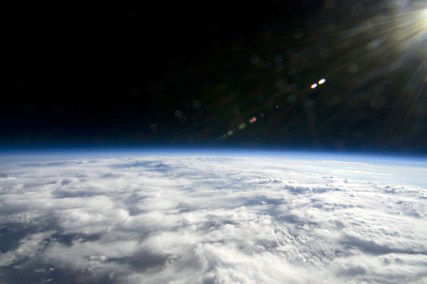My use of Google Reader has been almost non-existent this year, despite a few attempts to clear my queue and start over. Most of my new information comes from one of two places—Twitter and Twine. Today, the latter brought me a cool project with LEGO Mindstorms.
Two high-altitude balloons were used to launch 9 robots into space
Last Tuesday, a group of professors, students and robotics hobbyists launched robots into space at the H.A.L.E. (High Altitude Lego Extravaganza) event in Reno, Nevada. The launch celebrated the tenth anniversary of the LEGO Mindstorms platform.
The atmospheric weather balloon used to carry the robot experiments reached a maximum altitude of about 100,000 feet (30km) before bursting. The robots were then recovered safely after parachuting back down to Earth. Results from the experiment will be posted online at the LEGO Mindstorms site, but photos taken by one of the projects—”Gypsy” (named for the MST3K robot)—are available
elsewhere.
Gypsy’s creator is Brian Davis of Indiana University, who also contributed “Lil’ Joe,” a robot who set a world record for the longest Mindstorms NXT free-fall. Lil’ Joe is named for Col. Joseph Kittinger, a member of Project Excelsior who set a record by jumping out of a balloon at 100,000 feet.
“I love building LEGO mechanisms because the inherent limitations and versatility of the medium offer unique design challenges,” said Davis. “Additionally, since LEGO bricks are infinitely reusable, I can build and test prototypes much faster than I could in other mediums. I’m excited to take my experiments to a new level; I’ve never tried to build a robot that could function under these conditions and function right the very first time. 100,000 feet above ground is no place for a mistake.”
Source: The Chicago Examiner
Davis’ robot detached from the balloon at the maximum altitude, falling until a parachute was deployed. Lil’ Joe determined on its own when to deploy the parachute, based on conditions during descent. Officially, the robot was detached at 82,000 feet and was under free-fall for 80 seconds. Davis posted a YouTube movie explaining how the robot was packed for the mission.

A picture taken from the highest altitude
Other mindstorm projects in HALE included:
- Repeatedly dropping a tethered wiimote to measure the change in G-forces as a function of altitude
- Some 4th grade students studying the effect of high altitude (temperature and pressure) on Peeps, those little yellow marshmallows Amy loves so much
- Measuring ozone concentration, air pressure, temperature and reflected light with an RCX
- Measuring UV radiation as a function of altitude, capturing data from UV and temperature sensors
- Testing a mechanism to switch filtering papers and the particles they captured in the air and place the papers in a secured compartment
Carter spends much of his computer time working on the LEGO web site. We just downloaded the digital designer so he can construct his own LEGO creations. Building with Mindstorm isn’t that far away.
What is so appealing about the HALE project is its level of accessibility to space. Granted, procuring a few high-altitude balloons and the expertise to launch them isn’t an everyday skill. But it is clearly possible to couple amateur ideas with university science and come up with real projects. The photos taken by Davis’ robot is every bit as exciting as those images coming back from the Mars Phoenix, particularly when factoring in the personnel and resource investment of each project.